.pdf files of the following FABULOUS FOLIAGE selections are available for printing. You will find these at the bottom of this page

LEAVES are among the MOST SIGNIFICANT ELEMENTS to be considered when planning and planting visually exciting garden displays.
Think long and hard about using the foliage aspect of plants to best advantage, including an entire palette of perennials, trees, shrubs AND vines!
COLOUR
Many leaves are green, but some may be blue-green, others chartreuse, still others a deep purple. Some foliage is variegated – white/green or yellow/green – and still other plants have peach, coral or lime coloured foliage; some plants’ foliage have veins of a contrasting colour. Some perennials’ foliage changes as it ages; still other plants put on a spectacular display of foliage in the fall.
TEXTURE
Refers to size, shape and orientation of a plant’s leaves. There are three types of plant texture: FINE, MEDIUM, COURSE.
Plants with fine foliage have small, feathery, or narrow leaves with few gaps between them (ferns, ground covers).
Plants of medium texture fall somewhere on the spectrum between coarse and fine texture; their leaves are not large, nor small. Many plants fall into this category (heuchera, phlox).
Plants with coarse foliage have large leaves and/or large gaps between the leaves (hosta, bergenia, bearded iris).
Texture also includes the appearance of the foliage: shiny, smooth, velvety, ruffled, woolly, with a metallic sheen, or filigreed like lace.
The trick is to strategically add both coarse and fine textured plants between those with medium texture to create a balanced look.
FORM
Form relates to the shape and size of a plant or flower. A plant’s form is commonly referred to as its habit, and there are three basic plant habits: VERTICAL/UPRIGHT, MOUNDING, and HORIZONTAL/PROSTRATE. The foliage will be just as varied. Balanced garden designs include plants of all three forms.
The key thing to keep in mind is contrast. Knowing that foliage is often the focal point of a perennial bed, it is important to combine plants with different habits (spiky, round, flat, mound, fountain-like), foliage texture and colour to keep them from all blending together into one large mass.
When planting a perennial bed, one strikes to achieve balance as well as variety.
Sources:
Glattstein, J. (2013) Consider the Leaf: Foliage in Garden Design. Timber Press.
Chapman, K. & Salwitz, C. (2013). Fine Foliage: Elegant Plant Combinations for Garden and Container. Lynn’s Press.
Carey, J.R. (2022). The Ultimate Flower Gardener's Guide: How to Combine Shape, Color, and Texture to Create the Garden of Your Dreams. Timber Press.
Image: Judy Gray
TIPS ON PLANTING PERENNIALS
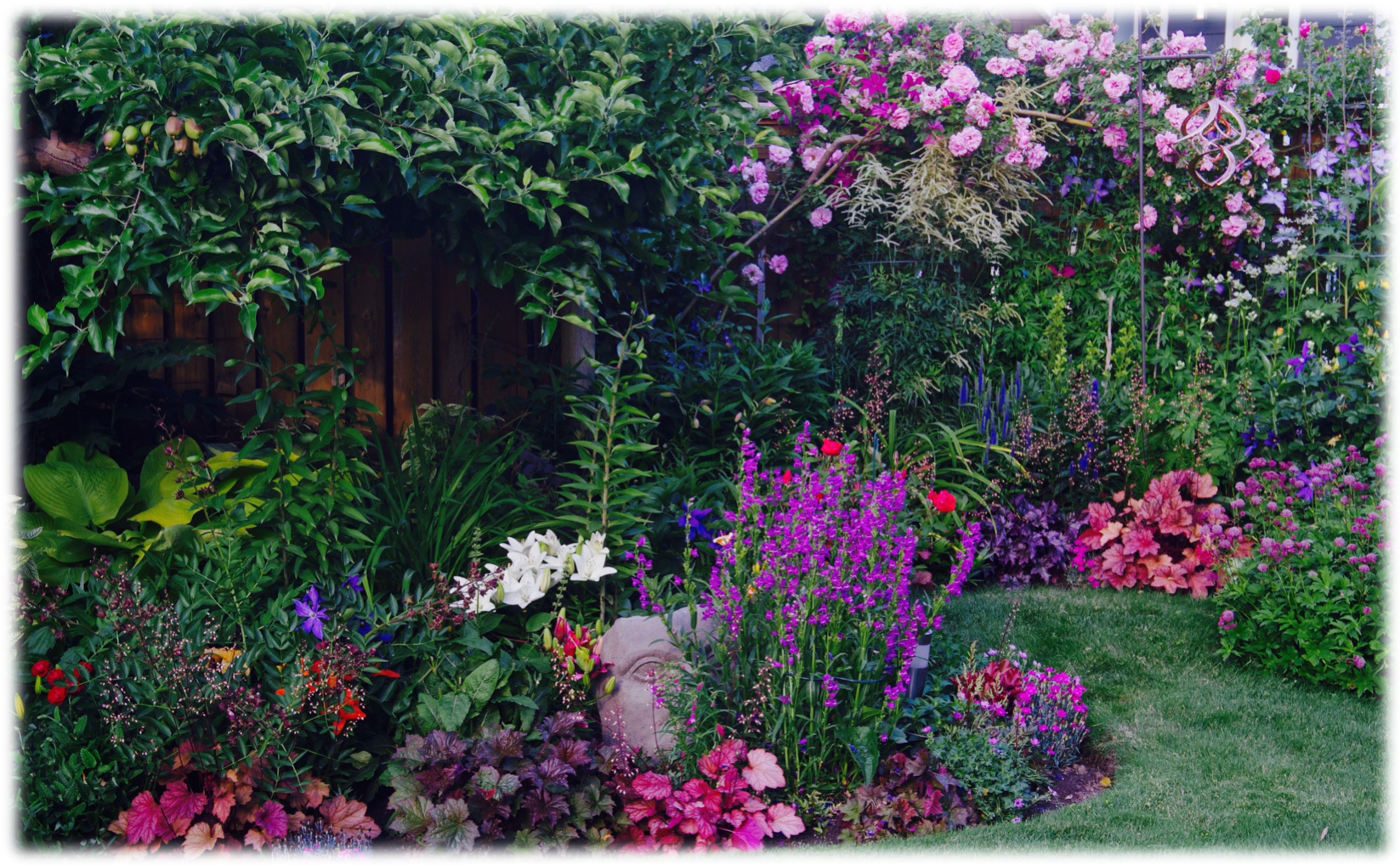
WHEN CHOOSING A PERENNIAL CONSIDER
- Growth Habit
- Mature Size
- Sun/Shade Needs
- Type Of Soil
- Foliage Texture
MUST KNOWS
FINAL SIZE – to prevent a vigorous plant overtaking a less vigorous specimen
ZONE the plant is hardy to
FINAL SIZE OF PLANT – Height/width are important. Is it better planted as a border or at the back of a bed?
PLANT HABIT – Vertical/upright, mounding, horizontal/prostrate.
Balanced garden designs include plants of all three forms. Juxtaposing plants with opposite forms create a delightful contrast.
SOIL PREFERENCE and WATER NEEDS to ensure long-term survival
LIGHT REQUIREMENTS – sun, partial shade, full shade
BLOOM TIME – if striving for colour throughout growing season
PEST/DISEASE TENDENCIES
INVASIVE SPECIES – is it invasive or does it spread rapidly?
LIFESPAN
READ PLANT TAG CAREFULLY especially if you wish to buy a particular cultivar. Some perennials can have numerous cultivars with quite different growth habits.
LEAVE FOLIAGE AND FLOWER HEADS on the plant for winter interest AND to provide a habitat for pollinators
COLOUR
Foliage colour is often at its most vibrant during the SPRING and EARLY SUMMER, though some foliage is the most glorious in early fall
Sources:
Pennisi, B. et al. University of Georgia Extension, Department of Horticulture. Landscape Basics: Success with Herbaceous Perennials. May 2022.
https://secure.caes.uga.edu/extension/publications/files/pdf/B%201424_4.PDF
Image: Judy Gray
DOUBLE BLOODROOT
Sanguinaria canadensis Multiplex
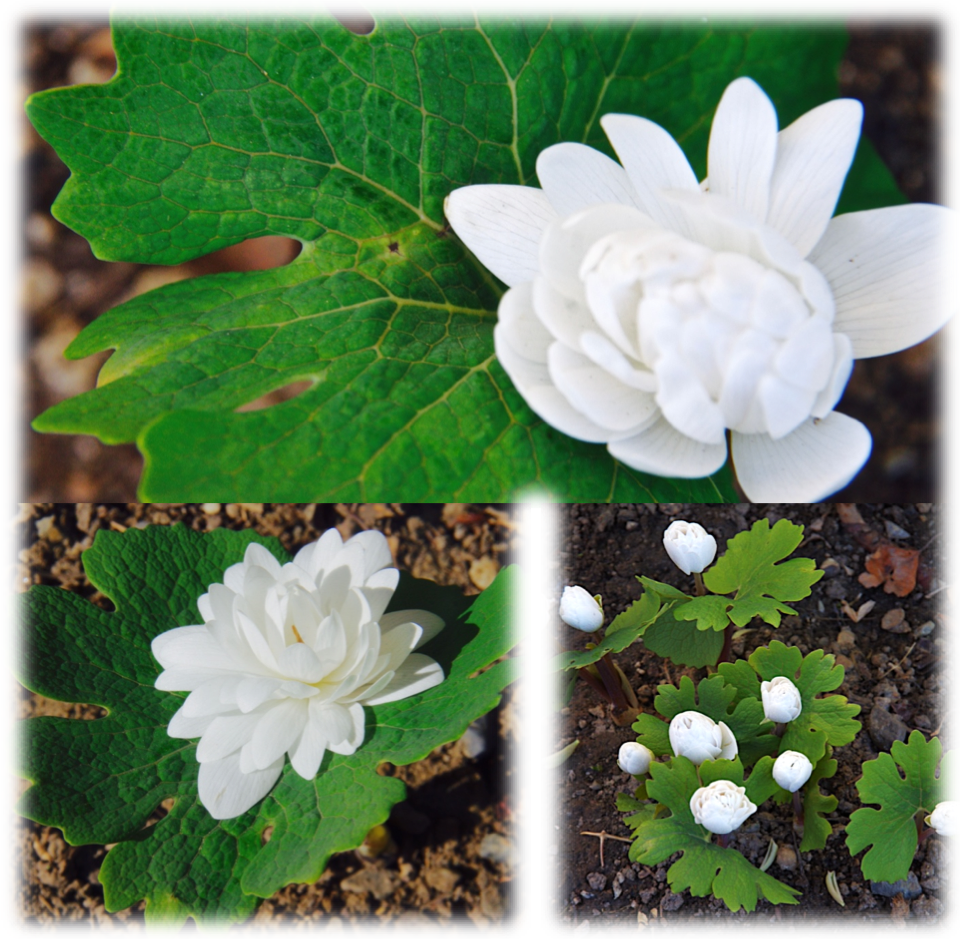
FOLIAGE
Beautiful blue-green kidney shaped fan foliage that remains tidy for months and eventually goes dormant in late summer.
FLOWERS
Pure white flowers, in early spring.
HARDINESS ZONES
4 to 5
LIGHT REQUIREMENTS
Partial sun/light shade to shade; a hidden gem in your light shade perennial bed.
SIZE
Plant grows to a height of 5-6 inches (12-15 cm); clump will slowly spread over a number of years; can be dug up and transplanted; this plant does not set seed.
WATER / SOIL REQUIREMENT
Moist well-drained soil.
PESTS
Diseases that infect bloodroot include Alternaria leaf blight, Botrytis (gray mold, leaf blight), and root rot (Pythium), BUT bloodroot is generally pest free.
Sources:
Missouri Botanical Garden Plant Finder
Missouribotanicalgarden.org
Images: Judy Gray
BARRENWORT
Epimedium
CULTIVARS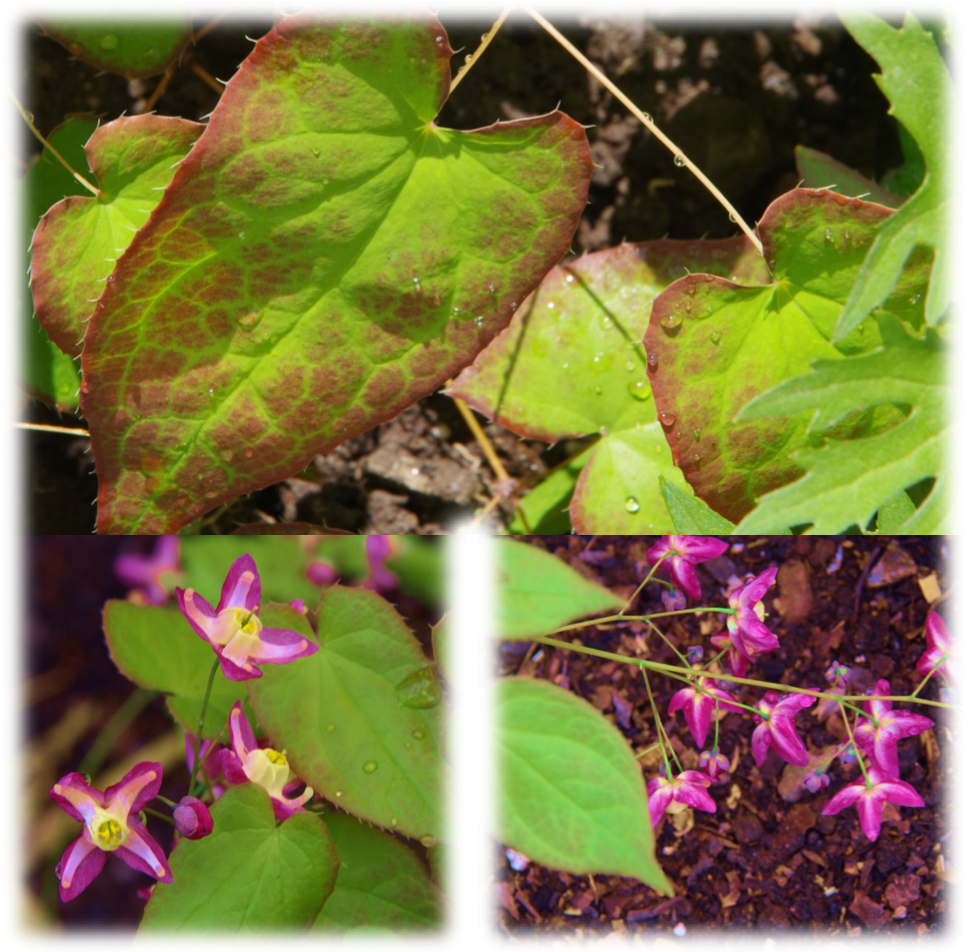
Several cultivars with light yellow or red flowers: Epimedium x rubrum / Epimedium sulphureum.
FOLIAGE
Emerges heart-shaped bright green in the spring; leaves have a lovely red flush around the edges and into the veins; loses colour in mid-summer but leaves redden again in the fall; leaves do not remain evergreen over winter and need to be removed in the spring.
FLOWERS
Clouds of tiny yellow or pink/red flowers appear on wiry stems.
HARDINESS ZONE
5
LIGHT REQUIREMENTS
Light shade / shade.
SIZE
Height: 9-12 inches (22-30 cm);
Width: 9-18 inches (22-40 cm); does spread, but slowly.
WATER / SOIL REQUIREMENT
Moist, well-drained soil.
PESTS
No major pests / diseases.
Sources:
Missouri Botanical Garden Plant Finder
Missouribotanicalgarden.org
Images: Judy Gray
BLEEDING HEART
Dicentra spectabilis – GOLD HEART
FOLIAGE
Beautiful gold leaves and light peach-coloured stems.
FLOWERS
Arching wands of heart shaped rose pink flowers with protruding white petals that dangle above the foliage. Blooms in mid-to-late spring for about 3 to 4 weeks.
HARDINESS ZONE
4-5
LIGHT REQUIREMENTS
Partial sun / light shade to shade.
SIZE
Height: 18 inches to 2.5 feet (45-75 cm); Width: 2-3 feet (60-90 cm). Plant towards the back of a perennial bed. This plant goes dormant in the summer and disappears, but will return in the spring. Mark the spot so you don’t dig it up! Spreads slowly and does not require pruning.
NOTE: Plant hostas, astilbes or ferns nearby to fill in the space when the bleeding heart goes dormant.
WATER / SOIL REQUIREMENT
Average water required, moist well-drained soil; neutral or slightly alkaline.
PESTS
No major pests / diseases.
TOXICITY
Toxic to humans and pets if ingested. Wear gloves if necessary when working with foliage – may aggravate skin allergies.
Source:
Missouri Botanical Garden Plant Finder
Missouribotanicalgarden.org
Image:
Judy Gray
SIBERIAN BUGLOSS
Brunnera macrophylla – JACK FROST CULTIVAR
CULTIVARS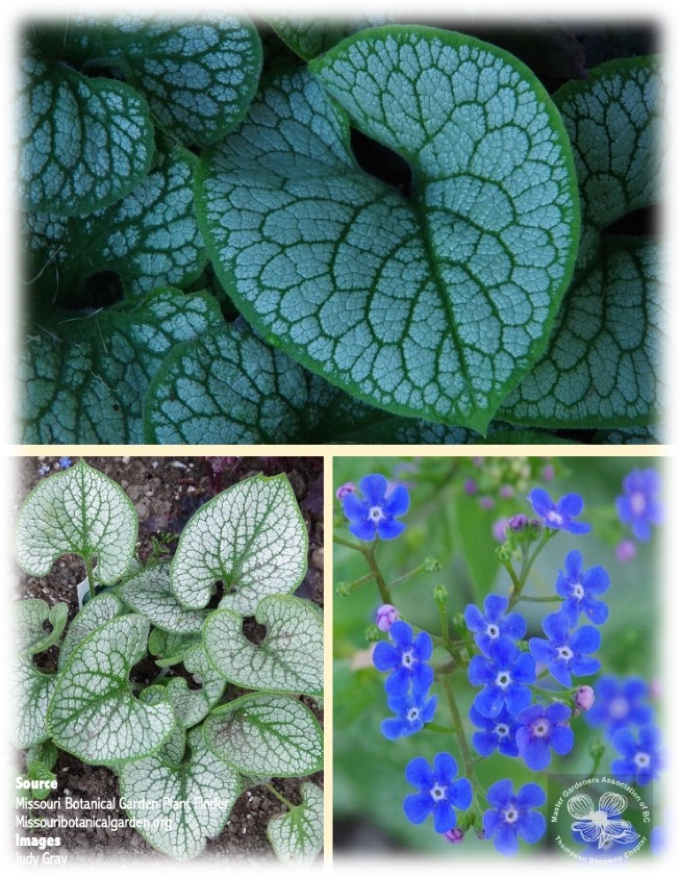
Other cultivars have slightly different coloration in the foliage, with slightly different veining – Silver Heart, Sea Heart, Alexander’s Great, Looking Glass.
FOLIAGE
Attractive heart-shaped, silver leaves edged and veined with dark green. Basal leaves form a foliage mound which remains attractive throughout the growing season. Foliage may scorch in hot summer sun.
FLOWERS
Small, blue, forget-me-not-like flowers with white centers that bloom in airy, branched racemes rising well above the foliage on slender stems to 18 inches (45 cm) tall in spring.
HARDINESS ZONE
4 to 5
LIGHT REQUIREMENTS
Partial sun / light shade to shade; foliage brightens up a shady area.
SIZE
Height: 12-18 in. (30-45 cm); Width: 18-30 in. (45-75 cm). Clumps slowly spread by creeping rhizomes to form thick ground covers. Plants may self-seed in optimum growing conditions.
WATER / SOIL REQUIREMENT
Easily grown in average, medium moisture, well-drained soil. Prefers moist, organically rich soils in shady areas. Generally intolerant of dry soils, but tolerates some dryness better than most other cultivars of this species.
PESTS
No serious insect or pest problems.
Sources:
Missouri Botanical Garden Plant Finder
Missouribotanicalgarden.org
Images: Judy Gray
JAPANESE PAINTED FERN
Athyrium niponicum
FOLIAGE
Colourful foliage, offering triangular, silvery leaves (fronds) that sport an arching habit. Grayish-green with purplish midribs, making them variegated ferns.
CULTIVARS
Athryium niponicum – described above, photos on the right.
Athryium ‘Ghost’ – Frosted apple green fronds emit a ghostly white light in the shade. Dark purple stems hold the broad fronds rigidly upright. Fronds darken slowly to a silvery green with burgundy accents. This selection is taller than many other Athyriums. Spreads slowly by shallow rhizomes.
FLOWERS
No flowers.
HARDINESS ZONE
4 to 8.
LIGHT REQUIREMENTS
Light to full shade; foliage brightens up a shady area of a perennial bed.
SIZE
Height: 12-30 in. (30-75 cm); Width: 12-30 in. (30-75 cm). Slow growing.
PLACEMENT
Woodland / shade gardens. Great in containers as a focal point – needs to be planted in the garden to overwinter.
WATER / SOIL REQUIREMENT
Easily grown in average soil. Prefers consistently moist, well-drained soil.
PESTS
No serious insect or pest problems.
Sources:
Fine Gardening – finegardening.com
Perennial Resource – perennialresource.com
The Spruce – thespruce.com
Images: Judy Gray
HEUCHERA | Coral bells | Alumroot
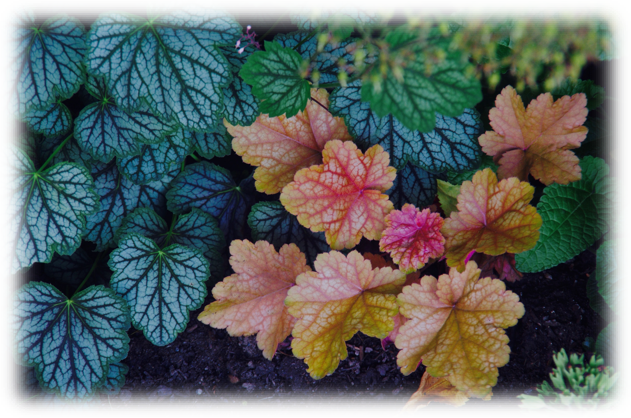
With SO MANY cultivars and different coloured foliage, this plant is AMAZING!
FOLIAGE
Basal clump of heart-shaped, 5-7 lobed, long-petioled leaves (8-12 cm wide), in a beautiful range of colours, with scalloped, ruffled, wavy or smooth edges.
CULTIVARS - SUN
Heuchera x villosa ‘Carnival Watermelon’ – coral
Heuchera ‘Obsidian’ or ‘Dolce Blackberry Ice’ or ‘Wildberry’ – dark purple
Heuchera ‘Peppermint Spice’ or ‘Green Spice’ or ‘Eco-Magnifolia’ – bright green/dark green with burgundy veins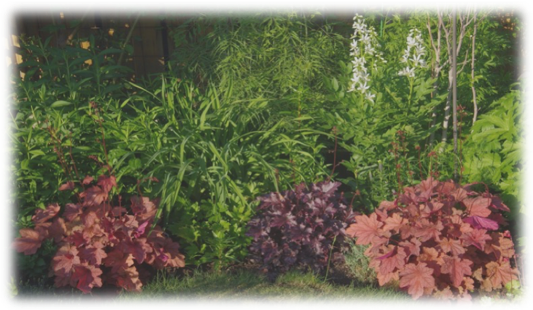
Heuchera x villosa ‘Caramel’ – apricot/amber foliage with crinkly leaves
Heuchera ‘Pewter Veil’ – silvery purple foliage with darker veins
Heuchera ‘Zipper’ – red/orange foliage with very ruffled leaves
CULTIVARS - SHADE
Heuchera ‘Lime Ricky’ or ‘Lime Marmalade’ or ‘Lemon Love’ – chartreuse – needs deep shade
Heuchera ‘Silver Scrolls’ or ‘Silver Gumdrop’ – silver 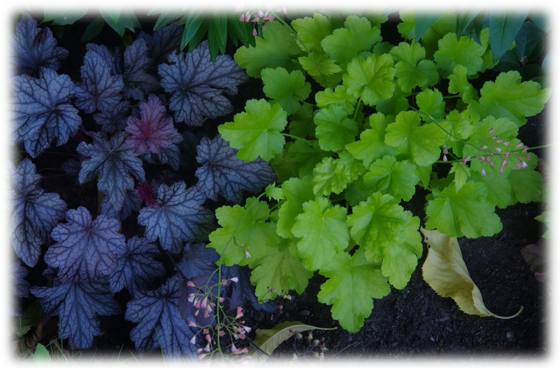
Heuchera ‘Electra’ or ‘Red Lightning’ – bright chartreuse green with strong red veins
Heuchera ‘Peach Flambe’ – soft coral
*NOTE: if you choose plants with strong coloured foliage, consider overall look.
FLOWERS
Colourful panicles of bell-shaped flowers: rose pink, red, hot pink or white (depending on the cultivar) are borne on sturdy stems rising up to 13 in (32 cm) above the foliage. Heuchera flowers bring an open, airy, informal flavour to the garden during part of the growing season. And if deadheaded, the flower show lasts quite a long time. Flowers are showy and a good cut flower.
HARDINESS ZONE
4 to 8.
LIGHT REQUIREMENTS
Full sun, light shade to full shade; in general, plants with darker coloured foliage can withstand more sunlight.
SIZE
Height: 7-14 in (20-35 cm); Width: 12-24 in (30-60 cm). When blooming, the flower stalks reach 12-28 in (30-70 cm) tall.
PLACEMENT
Beds, borders, rock gardens, woodland gardens and ideal as a ground-cover, edger along paths or in containers. Fabulous when planted in groups! Great in containers – but needs to be planted in the garden to overwinter.
WATER / SOIL REQUIREMENT
Prefer open, well-aerated soil with good drainage. Heucheras prefer neutral pH soils and while they will grow fine in slightly acidic soils, they will not fare well in extremely acidic soils.
PESTS
Easy to care for. Root rot or black vine weevil are possible diseases or pests. These do not seem to be a problem in Kamloops.
LIFESPAN
The only downside to Heuchera is that they are short-lived, unless they are divided every 3-4 years as the crown becomes woody. HOW TO DIVIDE: Dig up the plants and replant them a little deeper, with 1-2 inches of the stem sticking out of the soil. You can also lift the entire clump, cut away the older root stalks, and replant the youngest growth. Only divide if stem is getting higher and higher above the soil level. Some cultivars may need dividing only every 5-8 years.
Sources:
Perennial Resource – perennialresource.com
Piedmont Master Gardeners – piedmontmastergardeners.org
Plant Delights – plantdelights.com
Images: Judy Gray
BUGBANE | Baneberry | Cohosh | Snakeroot
Actaea simplex – Cimicifuga ramosa (HILLSIDE BLACK BEAUTY CULTIVAR)
CULTIVARS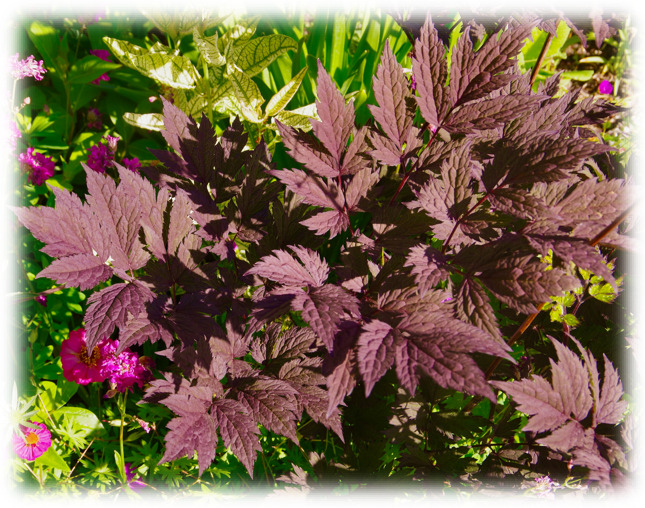
These cultivars have the same form but the foliage is not as dark:
‘Actaea Racemosa’ – green leaves.
‘Brunette’ – purplish/ black foliage, but not as dark as ‘Hillside Black Beauty’
FOLIAGE
Cimicifuga (‘Hillside Black Beauty’) has striking dark purplish-black finely divided foliage that does not fade as the season progresses.
FLOWERS
Gracefully arching wands of fragrant, one foot long, bottlebrush flowers, open white with a pale blush pink tinge. Blooms in late August/September. The flowers are packed in fluffy spikes along purple waving stems.
HARDINESS ZONE
3 to 8.
LIGHT REQUIREMENTS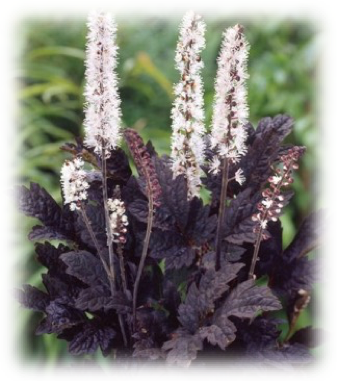
Partial sun / light shade – seems to tolerate midday sun.
SIZE
Foliage Height: 2.5 feet (45 cm.); Height with flowers: 5 feet (120-150 cm);
Width: 5-6 feet (150-180 cm). Quite a slow spreader.
WATER / SOIL REQUIREMENT
Easily grown in average soil. Prefers consistently moist, well-drained soil. Average water needs.
PESTS
No serious insect or pest problems.
PLACEMENT
Any perennial bed; dark foliage makes a great focal point/contrast with plants around it; plant midway in bed.
Sources:
Perennial Resource
Perennialresource.com
Images:
Judy Gray
Wiki Commons
LADY’S MANTLE (Mountain mantle)
Alchemilla mollis– Alchemilla mollis alpina (Alpine Lady’s Mantle Cultivar)
FOLIAGE
Dense mound of shiny green leaves divided into 5-7 leaflets that look like open palms. Adorned with wonderful silvery edges and covered in silky hairs. Smaller and more refined than the usual form of Lady’s Mantle.
FLOWERS
Short sprays of tiny chartreuse-yellow flowers appear in early summer.
HARDINESS ZONE
3 to 9.
LIGHT REQUIREMENTS
Full sun / partial shade.
SIZE
Foliage Height: 6-8 in (15-20 cm); Width: 8-12 in (20-30 cm). Clump will slowly spread over a number of years. Can be dug up, and divided easily.
WATER / SOIL REQUIREMENT
Average soil – sandy or clay. Neutral soil. Average water needs.
PESTS
Generally pest and disease free.
PLACEMENT
Great border plant for a perennial bed; also fine in containers or rock gardens. An easy and reliable plant that requires little attention.
OTHER CULTIVARS
‘Alchemilla mollis’ – larger leaves and larger plant than the Alpina cultivar; lighter green leaves that retain moisture beads after the rain. Gorgeous after rain or watering! Clusters of delicate star-shaped, greenish-yellow flowers appear in sprays just above the foliage from late spring to early summer. Flowers are great fillers for bouquets. This cultivar freely self-seeds and spreads more quickly than the Alpina cultivar. It is easy to dig up and divide if clump is getting too big.
Sources:
Gardenia.net
Perennials.com
Images: Judy Gray
FALSE SUNFLOWER (Ox-eye Sunflowers)
Heliopsis helianthoides – LORAINE SUNSHINE and SUNSTRUCK CULTIVARS
VARIEGATED FOLIAGE CULTIVARS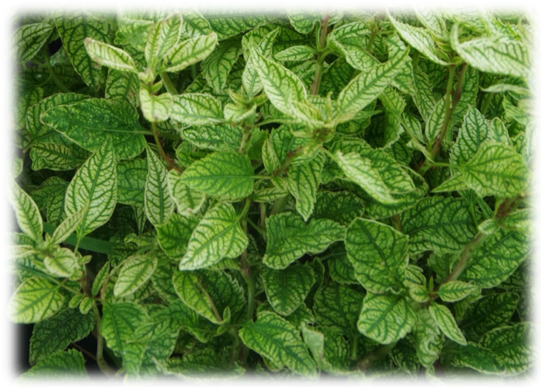
‘Lorraine Sunshine’
‘Sunstruck’ – more compact, has more ray florets and a deeper flower colour than ‘Lorraine Sunshine.’
FOLIAGE
Coarse, serrate, ovate to lance-shaped, variegated leaves are cream and green colour with green veins. Bushy, well-branched form. Greens up a bit in the heat of summer.
FLOWERS
2-2.5 in (4-5 cm) golden yellow single flowers atop stiff stems that seldom need staking; blooms throughout the summer if deadheaded.
HARDINESS ZONE
4 to 9.
LIGHT REQUIREMENTS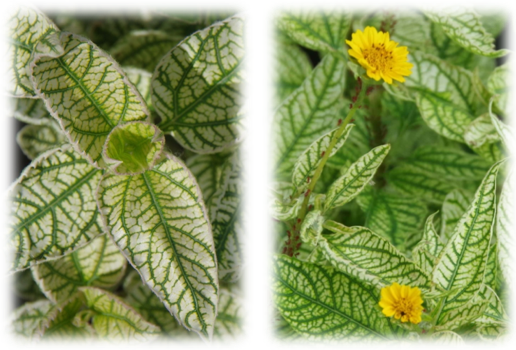
Full sun; heat and drought tolerant; may need staking if in too much shade
SIZE
Height: 2-3 feet (60-90 cm); Width: 12-14 inches (30-35 cm). Grows in clump.
GROWTH RATE
Average growth rate; if not deadheaded, will seed and new plants will maintain the variegated foliage; easy to dig and divide.
WATER / SOIL REQUIREMENT
Average dry to medium soil that is well-drained; will tolerate poor soil.
PESTS
Generally pest free but some susceptibility to aphids.
PLACEMENT
Excellent tall perennial for the middle or back of the flower border. Can be used in containers, as a cut flower, as a focal piece or to attract butterflies.
Sources:
Gardenia.net
Missouribotanicalgarden.org
Waltersgardens.com
Images: Judy Gray
HOSTA (PLANTAIN LILY)
CULTIVARS
There are over 600 Hosta cultivars available. See the following page for a sampling of diverse cultivars.
FOLIAGE
Clump forming perennial grown mainly for its foliage which can vary from chartreuse to dark green, gold, blue, white or a combination of these colours. Foliage comes in a wide range of sizes, shapes and forms – from huge to tiny, cupped, flat, heart-shaped, lance-shaped, vase-shaped, corrugated, deeply veined, folded, rippled, glaucous, misted, streaked and twisted to name a few!
FLOWERS
Bell or funnel-shaped flowers on stalks that rise well above the foliage and bloom in late spring or summer. Flowers are most often pink, lilac, or lavender, but may also be white. Some of the cultivars with white flowers are delicately scented.
HARDINESS ZONES
3 to 9.
LIGHT REQUIREMENTS
Partial shade to full shade, although some cultivars can tolerate quite a bit of sun. Vigorous Hosta can survive better in deep shade. Hostas with thicker lighter coloured leaves handle sun better. Fragrant Hosta can handle sun and heat better.
SIZE
Varies greatly depending on the cultivar. Height: Miniature Hosta – 2-3 in. (5-10 cm); giant Hosta –3 feet (1 metre); Other cultivars can be 30 cm tall and wide. A hosta clump will slowly spread from its rhizomatous roots over a number of years. Can be dug up and divided easily.
GROWTH RATE
Fast, medium. and slow-growing varieties. Smaller varieties tend to grow fastest and can reach their mature size in 3 to 5 years. Larger types can take 5 to 7 years.
WATER / SOIL REQUIREMENT
Average soil – sandy or clay. Neutral soil. Average water needs, but do not like overly dry conditions.
PESTS
Generally pest and disease free but slugs and snails are attracted to the foliage, chewing jagged holes in the leaves. Leaves can be severely damaged by hail storms.
PLACEMENT
Great plant for shady areas. A shady bed planted with a variety of different hosta cultivars can create a wonderfully diverse panorama. Very effective in groups or massed. Good background plant. Most require very little attention. Can be used in containers, as a cut flower, as a focal piece, or to attract butterflies.
Sources:
Nhhostas.com
Missouribotanicalgarden.org
Perennialresource.com
Images: Judy Gray
HOSTA CULTIVARS
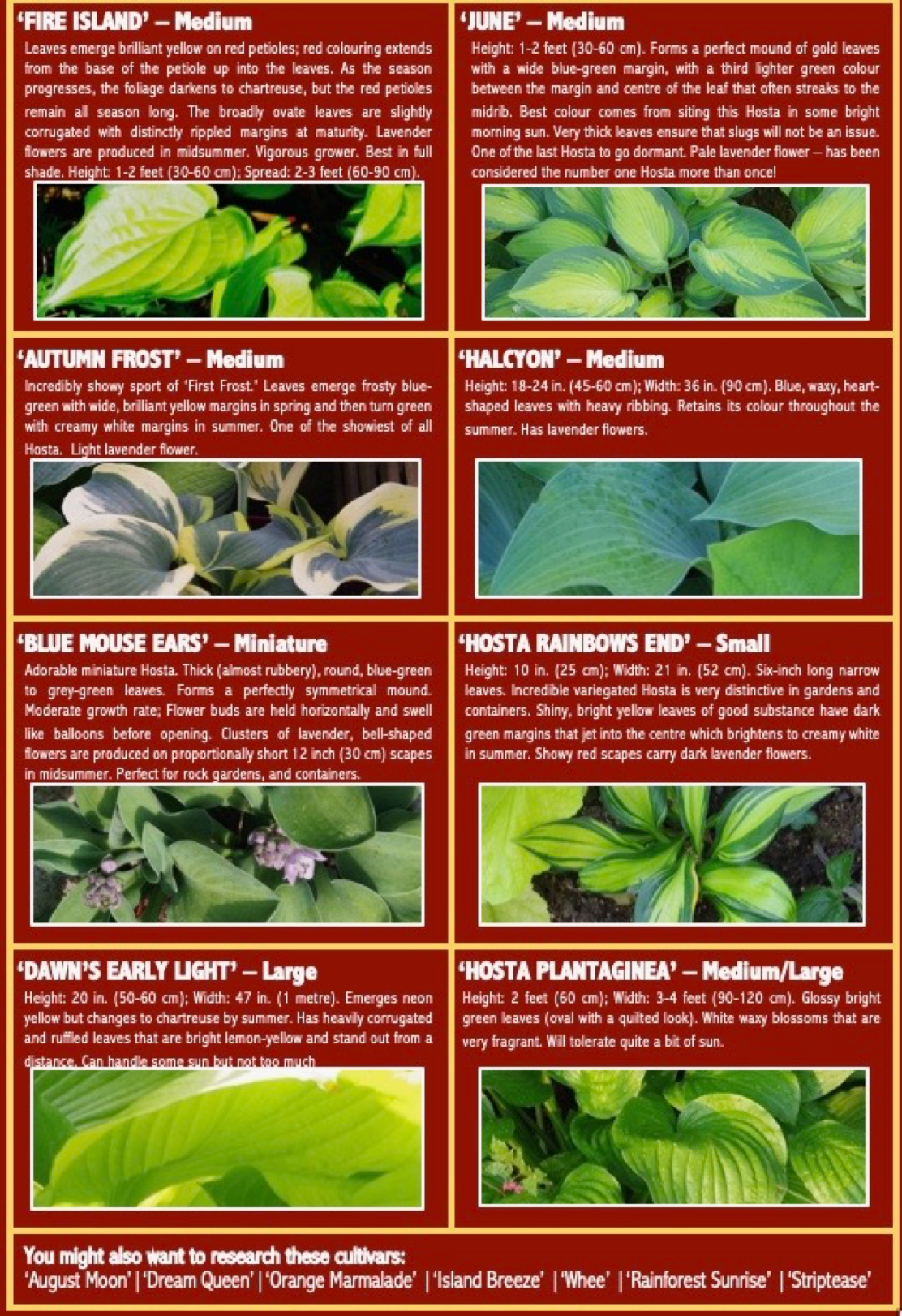
MUKDENIA ROSSI (MUKDENIA)
CULTIVAR
Karasuba (Crimson Fans)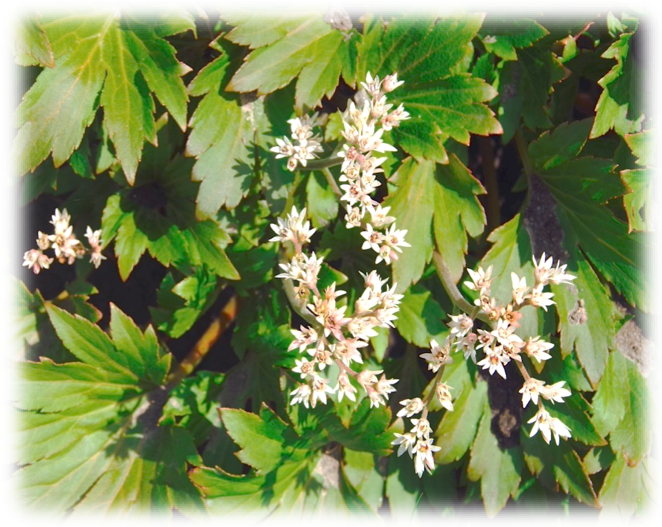
FOLIAGE
Thickly textured, glossy green foliage. Leaves are rounded, palmate lobed and fan-shaped – up to five inches across. Emerge bright green in the spring; but beginning in summer, the dark green leaves develop red tones that creep inward from the edges. Fire red fall colour. The foliage forms a low, spreading mound.
FLOWERS
Delicate panicles of starry white flowers in spring; held well above the foliage.
HARDINESS ZONE
4 to 9.
LIGHT REQUIREMENTS
Best grown in part shade. In more dense shade, the attractive red fall colour will not be as intense. Tolerates full sun, but If grown in full sun, consistent moisture is important.
SIZE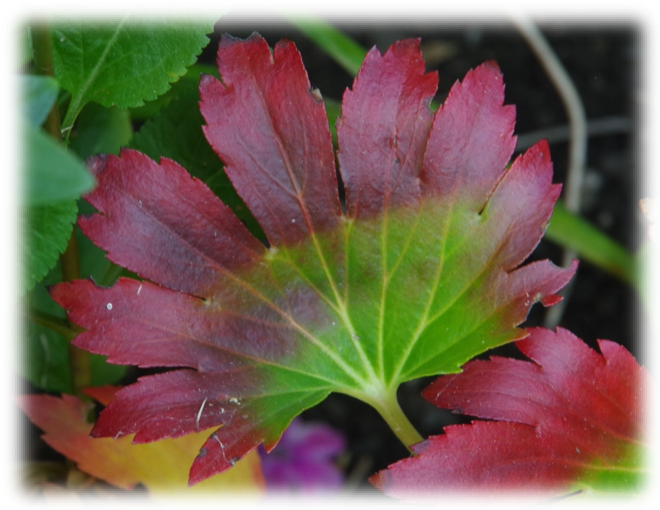
Height: 10-20 in. (20-40 cm); Width: 1-2 feet (30-60 cm).
GROWTH RATE
Slow grower, spreads over time by short creeping rhizomes. Plants may self-seed in optimum growing conditions. Can be dug and divided in spring; best done just before the leaf buds expand.
WATER / SOIL REQUIREMENT
Moist, fertile, well-drained soils. Average pH.
PESTS
Generally pest free but some susceptibility to slug damage.
PLACEMENT
Ground cover for shady areas. Woodland gardens. A good border plant in perennial beds.
Sources:
Hort.extension.wisc.edu
Missouribotanicalgarden.org
Waltersgardens.com
Images: Judy Gray
AMSONIA (BLUESTAR)
AMSONIA HUBRICHTII – NARROWLEAF BLUESTAR cultivar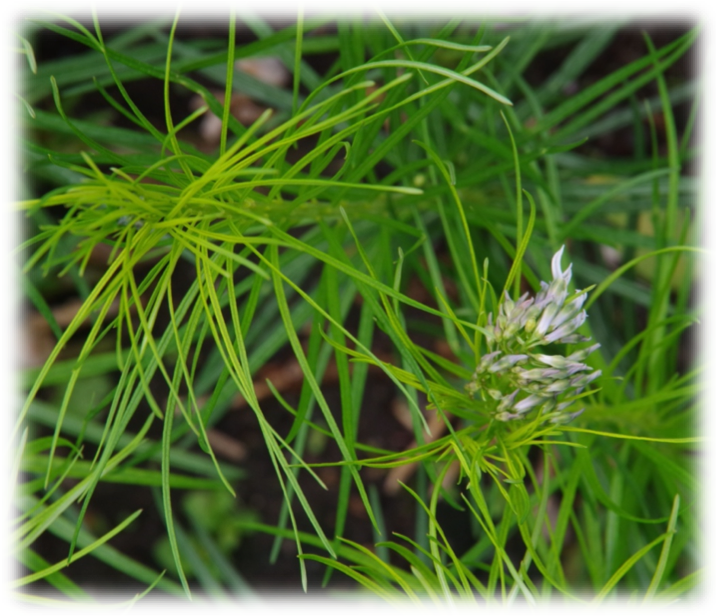
CULTIVARS
NOTE: Other cultivars have very different foliage.
FOLIAGE
A southern native with very narrow, needle-like leaves that line the stems like bottlebrushes. Valued for its golden yellow fall colour. Best fall foliage colour usually occurs if planted in full sun, but flowers generally last longer if given some afternoon shade in hot sun areas. Stems tend to open up and flop in too much shade. Feathery, soft-textured, needle-like, alternate leaves are bright green in spring and summer, but turn bright gold in autumn. Great foliage texture and fall colour.
FLOWERS
Produces 2-3 in. clusters of small, light blue, star-shaped flowers in June / July.
HARDINESS ZONE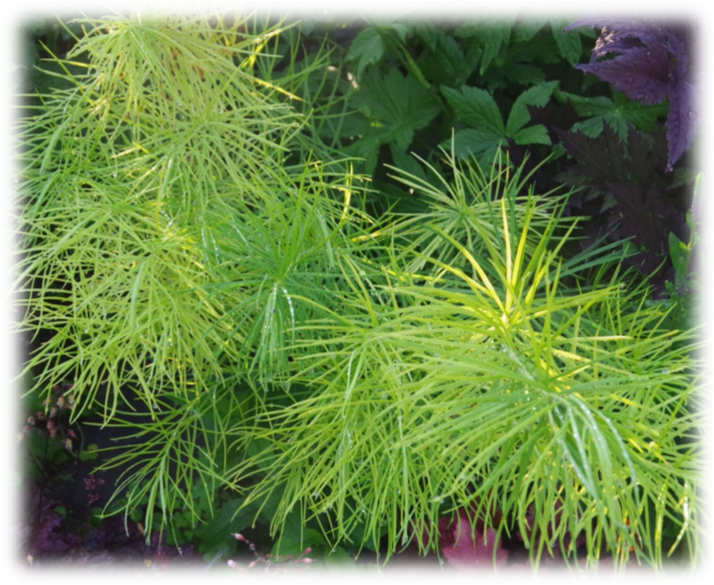
5
LIGHT REQUIREMENTS
Full sun to part shade.
SIZE
Height: 1-1.5 feet (30-40 cm); Width: 1-2 feet (30-60 cm).
GROWTH RATE
Slow grower. Can be dug and divided in early spring before the new growth starts..
WATER / SOIL REQUIREMENT
Medium. Well-drained soil, but will tolerate drought conditions once established.
PESTS
No serious pest or disease problems.
PLACEMENT
Borders, rock gardens, native plant garden, cottage garden or open woodland area.
Sources:
Missouribotanicalgarden.org
Perennials.com
Perennialresource.com
Images: Judy Gray
HARDY PERENNIALS WITH EXCEPTIONAL OR UNUSUAL FOLIAGE
If you decide to purchase one of these, take care to ensure you find the correct cultivar as many of these perennials have quite a number of cultivars and not all have the foliage described.



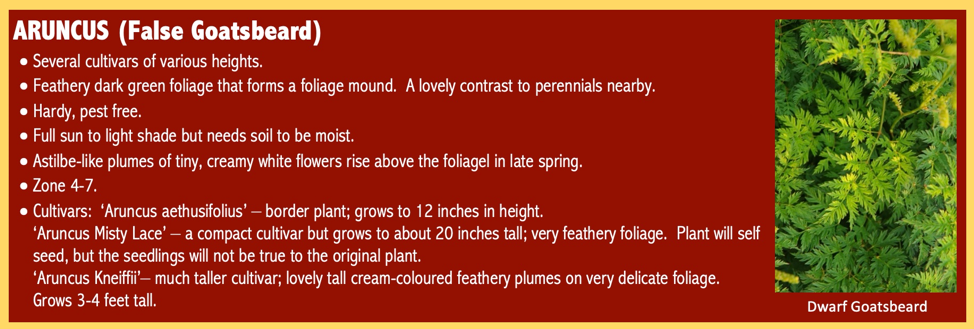
Sources:
Gardenia.net – www.gardenia.net/search
Missouri Botanical Garden – www.missouribotanicalgarden.org
Images: Judy Gray
| Attachment | Size |
|---|---|
| FFF 1 - ASPECTS OF FOLIAGE TO CONSIDER.pdf | 542.33 KB |
| FFF 2 - TIPS ON PLANTING PERENNIALS.pdf | 494.19 KB |
| FFF 3 - DOUBLE BLOODROOT.pdf | 589.51 KB |
| FFF 4 - BARRENWORT.pdf | 545.88 KB |
| FFF 5 - BLEEDING HEART.pdf | 1.86 MB |
| FFF 6 - SIBBERIAN BUGLOSS.pdf | 435.67 KB |
| FFF 7 - JAPANESE PAINTED FERN.pdf | 373.97 KB |
| FFF 8 - HEUCHERA.jpg_.pdf | 535.12 KB |
| FFF 9 - BUGBANE.pdf | 730.52 KB |
| FFF 10 - LADY'S MANTLE.pdf | 584.39 KB |
| FFF 11 - FALSE SUNFLOWER.pdf | 692.63 KB |
| FFF 12 - HOSTA 1 - GENERAL.jpg_.pdf | 1.06 MB |
| FFF 12 - HOSTA 2 - CULTIVARS.jpg_.pdf | 570.41 KB |
| FFF 13 - MUKDENIA ROSSI.pdf | 550.87 KB |
| FFF14 - AMSONIA.pdf | 544.82 KB |
| FFF15 - Assorted Plants.pdf | 591.48 KB |
